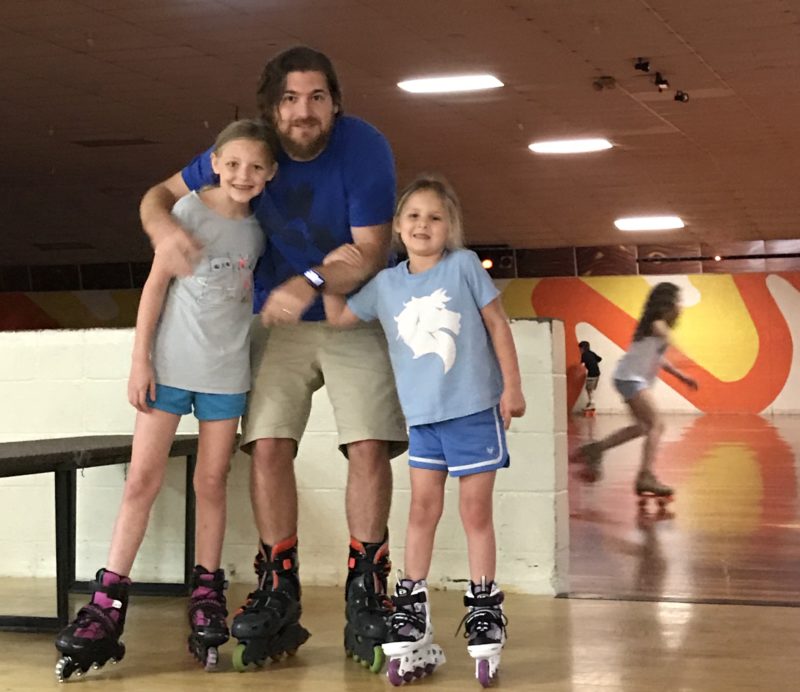Zac Gordon is not your average spinal CSF leak patient. As a quirky stuntman, he charmed Howard Stern on “America’s Got Talent.” As a gym instructor, he teaches kids “ninja” parkour skills. Just 4 months after spinal surgery, he is back to doing flips again.

Zac’s symptoms began in 2012, after having his wisdom teeth removed. He had such vertigo and head pain that being upright for even a short amount of time made him vomit. His uncle, a doctor, suspected he might be suffering from a spinal cerebrospinal fluid (CSF) leak. A CSF leak at the level of the spine causes loss of this precious fluid around the brain and spinal cord, which manifests with headache and other symptoms that are worse when upright. Zac had an epidural blood patch, the most common initial treatment, which provided some relief, but not for long. He found ways to live with his symptoms, trying to continue to work out and perform stunts and be present for his wife and young children; but eventually he couldn’t tolerate it anymore. In 2017, he traveled to see Dr. Peter G. Kranz, a neuroradiologist at Duke University, where he and his team performed diagnostic imaging and several rounds of epidural patching with fibrin sealant and blood. Zac ultimately opted for a surgical solution to repair his leak this past February.
Zac took his recovery slowly — for Zac, that is. Most spinal CSF leak patients are advised to avoid any bending, lifting, or twisting for several months, but Zac was back to working out after a month and a half. He tried to listen to his body, backing off when things got intense; but still managed to do the kind of cardio and light weightlifting to which even a fully healthy person could aspire. At four months post-surgery, he’s now very close to his goal of being able to work out every day for a month without feeling strain and without any of his leak symptoms recurring.
Still, it’s the little things that remind him how far he’s come. He can do yardwork now. The other day, he attended his daughters’ end-of-school-year parties, taught 35 kids in his ninja class, worked out for an hour, and cleaned the house. By the end of it, he was tired — but he wasn’t hurting. More importantly, he has finally able to pick up and hold his daughters — something he had truly missed. “My youngest just turned six, and I was able to pick her up for the first time in over a year. That was one of the best moments.”
He still grapples with occasional rebound high CSF pressure symptoms, a dull head pain when he’s laying down, especially in the morning. This is a common complication following treatment, which is usually self-limited but occasionally requires treatment with medication. But he’s had no low CSF pressure symptoms since his surgery.
“Life is extremely different now,” he says. “It’s kind of crazy. You can’t do a lot for so long because you’re so restricted, and you put so many things off, and you’re in so much pain and everything’s hard—and then you’re better and things are slowly coming back, and you almost forget that you were in pain. Because life doesn’t stop, it just keeps going. So I try to think about that, and I have a big scar on my back to remind me.”
The biggest thing he learned through his nearly six years of coping with pain and physical limitations due to his spinal CSF leak was also the hardest: staying positive. Especially when living with pain and uncertainty, he says, “staying positive and having a plan and having hope that you’re going to get better can go a long way towards making that happen.”
He recently successfully did a forward flip off a diving board into a swimming pool, just 4 months after his spinal surgery to repair the spinal CSF leak that was the cause of his positional headache and other symptoms. He had missed doing flips, feeling the weight of his body as he flies through the air. As for the future, he hopes to celebrate his recovery by doing a three-mile, 18-obstacle Spartan race this September.
Intracranial hypotension due to spinal CSF leak is often called “low pressure headache”, which references the low volume and pressure of CSF that causes the most common symptom of positional headache. June 23 is Low Pressure Headache Awareness Day during Migraine and headache Awareness Month, #MHAM. Learn more HERE.

